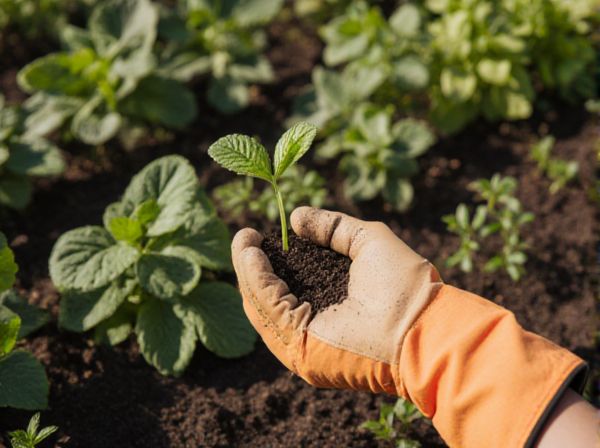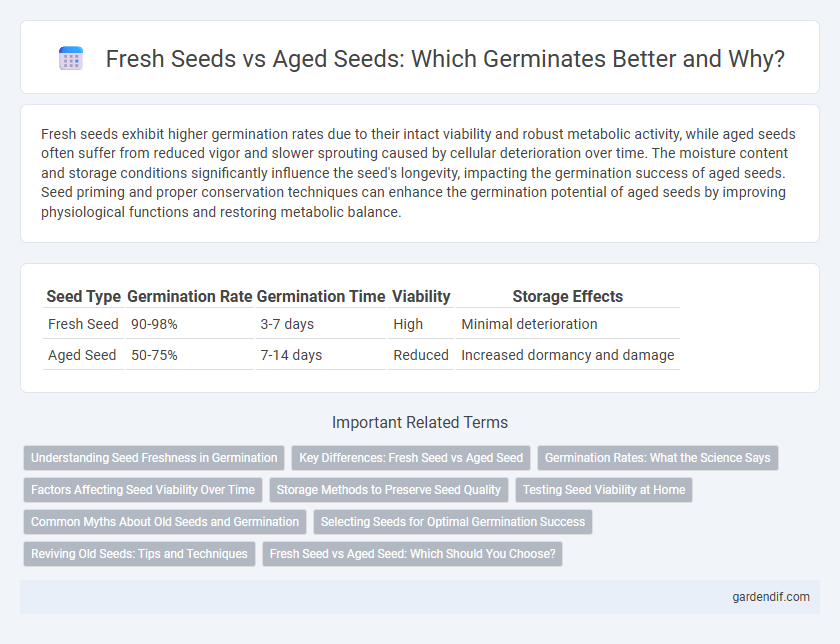
Fresh Seed vs Aged Seed Illustration
Fresh seeds exhibit higher germination rates due to their intact viability and robust metabolic activity, while aged seeds often suffer from reduced vigor and slower sprouting caused by cellular deterioration over time. The moisture content and storage conditions significantly influence the seed's longevity, impacting the germination success of aged seeds. Seed priming and proper conservation techniques can enhance the germination potential of aged seeds by improving physiological functions and restoring metabolic balance.
Table of Comparison
| Seed Type | Germination Rate | Germination Time | Viability | Storage Effects |
|---|---|---|---|---|
| Fresh Seed | 90-98% | 3-7 days | High | Minimal deterioration |
| Aged Seed | 50-75% | 7-14 days | Reduced | Increased dormancy and damage |
Understanding Seed Freshness in Germination
Seed freshness directly impacts germination rates, with fresh seeds showing higher vitality and faster sprouting compared to aged seeds. Fresh seeds retain optimal moisture content, enzymatic activity, and cellular integrity, essential for successful germination. In contrast, aged seeds often experience reduced vigor due to degradation of stored nutrients and increased susceptibility to fungal infections.
Key Differences: Fresh Seed vs Aged Seed
Fresh seed typically exhibits higher germination rates due to greater moisture content and viability compared to aged seed, which often suffers from decreased vigor and slower sprouting. Enzymatic activity and metabolic processes in fresh seeds are more robust, promoting rapid radicle emergence, while aged seeds may experience impaired cellular functions resulting in delayed or uneven germination. Storage conditions such as temperature and humidity significantly influence seed aging, with prolonged storage accelerating deterioration and reducing seedling establishment success.
Germination Rates: What the Science Says
Fresh seeds generally exhibit higher germination rates compared to aged seeds due to greater viability and intact seed coat integrity. Scientific studies indicate that as seeds age, biochemical and physiological changes reduce their germination potential by impairing enzyme activity and hormonal balance. Optimal storage conditions can mitigate viability loss, but fresh seeds consistently outperform aged seeds in germination efficiency.
Factors Affecting Seed Viability Over Time
Fresh seeds typically exhibit higher germination rates due to their optimal moisture content and intact seed coat, which preserve essential enzymes and nutrients. Over time, aged seeds experience a decline in viability caused by factors such as moisture loss, enzymatic degradation, and oxidative damage, resulting in reduced energy reserves and impaired embryo development. Environmental conditions like temperature, humidity, and storage methods critically influence the rate of seed aging and viability retention.
Storage Methods to Preserve Seed Quality
Fresh seeds maintain higher viability and germination rates compared to aged seeds, which often suffer from reduced vigor due to cellular degradation. Optimal storage methods such as low humidity levels (below 8%) and cool temperatures (around 4degC) significantly slow metabolic processes, preserving seed moisture and viability. Vacuum sealing and airtight containers further protect seeds from oxidative damage, fungal contamination, and fluctuations in temperature, ensuring better germination potential over extended periods.
Testing Seed Viability at Home
Fresh seeds typically exhibit higher germination rates due to intact cell structures and stored nutrients, making them ideal for home viability testing. Aged seeds may show reduced germination due to moisture loss and cellular degradation, requiring more precise methods such as the paper towel test to assess viability accurately. Home testing methods focus on observing seed swelling, root emergence, and seedling vigor within 7 to 14 days for reliable results.
Common Myths About Old Seeds and Germination
Fresh seeds generally exhibit higher germination rates compared to aged seeds due to their maintained vigor and moisture content. Common myths suggest that old seeds lose all viability, but many seeds can remain viable for years if stored properly in cool, dry conditions. Seed dormancy rather than age often influences germination success, meaning some aged seeds may require special treatments like scarification or stratification to sprout effectively.
Selecting Seeds for Optimal Germination Success
Fresh seeds exhibit higher viability and faster germination rates compared to aged seeds, which often suffer from reduced vigor and decreased moisture content. Selecting fresh seed batches ensures robust embryo health, leading to uniform seedling emergence and improved crop establishment. Monitoring seed storage conditions and testing germination percentage before planting further enhances germination success and long-term yield potential.
Reviving Old Seeds: Tips and Techniques
Reviving old seeds requires pre-soaking them in water for 12-24 hours to rehydrate and soften the seed coat, improving germination rates compared to fresh seeds. Scarification methods such as gently sanding or nicking the seed coat can further enhance water absorption for aged seeds. Temperature control with consistent warmth around 70-85degF (21-29degC) and maintaining optimal moisture levels in the growing medium significantly boost the success of germinating aged seeds.
Fresh Seed vs Aged Seed: Which Should You Choose?
Fresh seeds typically exhibit higher germination rates due to better moisture content and intact cellular structures, making them ideal for reliable crop establishment. Aged seeds often face reduced viability caused by moisture loss and cellular damage, which can lead to slower or uneven germination. Choosing fresh seeds ensures optimal growth potential, while aged seeds may be suitable only for non-critical applications or testing purposes.
Fresh Seed vs Aged Seed Infographic

 gardendif.com
gardendif.com